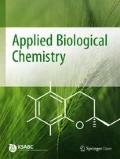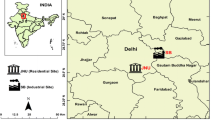Abstract
Halophyte community was established for dust prevention in Saemangeum reclaimed land from 2006 to 2008. In the present study, the functions of halophyte community were examined on-site in aspects of dust collection and nutrient absorption. In dust collection experiments, total suspended particulate (TSP) decreased through transplanted halophyte community and the reduction effect continued to 50 m leeward, which was 5.6 times of plant height. TSP reduction behind in-situ halophyte communities amounted to 25.6% on seven-monthly average. TSP collected within four halophyte communities varied among halophytic species in the field. Harvested in the reclaimed land, halophytic samples contained significant amount of nitrogen (0.84 to 1.71% of dry weight), P2O5 (0.05 to 0.21% of dry weight), and Na+ (0.08 to 3.20% of dry weight). On the basis of halophyte community area in 2006, the amount of total nitrogen, P2O5 and Na+ absorbed by Suaeda asparagoides was estimated up to 404,000, 47,000, and 498,000 kg, respectively. These results implied that halophyte communities are capable of both collecting significant dust particulates and absorbing of nitrogen, phosphorus, and sodium in the reclaimed land.
Similar content being viewed by others
References
Abideen Z, Ansari R, and Khan MA (2011) Halophytes: Potential source of ligno-cellulosic biomass for ethanol production, Biom Bioe 15, 1–5. doi: 10.1016/jbiombioe.2011.0123.
Bitog JP, Lee IB, Hwang HS, Shin MH, Hong SW, Seo IH et al. (2011) A wind tunnel study on aerodynamic porosity and windbreak drag. Forest Sci Tech 7, 8–16.
Bitog JP, Lee IB, Hwang HS, Shin MH, Hong SW, Seo IH et al. (2012) Numerical simulation study of a tree windbreak. Biosystems Eng 3, 40–48.
Bitog JP, Lee IB, Shin MH, Hong SW, Hwang HS, Seo IH et al. (2009) Numerical simulation of an array of fences in Saemangeum reclaimed land. Atmos Environ 43, 4612–4621.
Braun-Blanquet J (1964) Planzon Soziologie, 3.Auf, Springer, USA.
Choi BG (1998) A study on the use of halophytes on the reclaimed land in landscape architecture. Korean J Landscape Architecture 26, 278–287.
Flowers TJ and Colmer TD (2008) Salinity tolerance in halophytes. New Phytol 179, 945–963.
Hong SW, Hah YC, and Choi YK (1968) Biological improvement of reclaimed land (): Desalination effects of saline soil by the growth of certain halophytes. J Soc Plant Sci 12, 7–14.
Hwang HY, Lee IB, Chang PW, Hong SW, Seo IH, and Lee SY (2006) Monitoring of dust emission at a reclaimed land and its 3-D aerodynamic modeling, ASABE, 062055. USA.
Hwang HY, Lee IB, Shin MH, Hong SW, Seo IH, Yoo JI et al. (2008) Monitoring of the fugitive and suspended dust dispersion at the reclaimed land and neighboring farms: monitoring in Gunsan. J Korean Soc Agri Eng 50, 39–50.
Hwang HY, Lee IB, Shin MH, Hong SW, Seo IH, Yoo JI et al. (2009) Monitoring of the fugitive and suspended dust dispersion at the reclaimed land and neighboring farms: monitoring in Gimje. J Korean Soc Agri Eng 51, 59–67.
Jung YS, Joo JH, Kwon SC, Im JN, Shin MH, and Choi KW (2004) Wind erodibility of the Saemangeum tideland reclamation project area. Korean J Soil SciFer 37, 207–211.
Kim CH, Lee KB, Cho DS, and Myoung H (2006) The study on the flora and vegetation of salt marshes of Mankyeong River estuary in Jeonbuk. Korean J Env Ecol 20, 288–298.
Laegdsgaard P (2006) Ecology, disturbance and restoration of coastal salt marsh in Australia: a review. Wetlands Ecol Manage 14, 379–399.
Min BM (1990) On the accumulation of minerals with the plant species in a reclaimed land. Korean J Ecol 13, 9–18.
Muhammad A (2004) Some important physiological selection criteria for salt tolerance in plants. Flora 199, 361–376.
NIAST (National Institute of Agricultural Science and Technology) (2000) Methods of soil and plant analysis. Sammi Press, Korea.
Quadir M and Oster JD (2004) Crop and irrigation management strategies for saline-sodic soils and water aimed at environmentally sustainable agriculture. Total Environ 323, 1–19.
Roggo M, Glauser M and Aragno M (1987) Methane digestion of a mixture of reeds and sludge from a purification plant. Bull Sco Neuchatel Sci Nat 110, 101–108.
Seo IH, Lee IB, Shin MH, Lee GY, Hwang HS, Hong SW et al. (2010) Numerical prediction of fugitive dust dispersion on reclaimed land in Korea. Transactions of the ASABE 53, 891–901.
Seo JC (2010) Morphological changes of the beach and foredune by sand fences: A case of Shindu coastal dune area. J Korean Geomorphological Association 17, 85–93.
Shim HB, Cho WB, and Choi BH (2009) Distribution of halophytes in coastal salt marsh and on sand dunes in Korea. Korean J Plant Taxon 39, 264–276.
Shin MH and Kim CH (2010) Traits of water level control by sluice gates and halophyte community formation in Saemangeum. Korean J Environ Ecol 24, 186–193.
Shin MH, Kim CH, and Kim MK (2012) Classification of halophyte community growth and its relationship with soil chemical properties in Seamangeum Reclaimed Land. J Korean Soc Appl Biol Chem 55, 599–605.
Tabata S, Shirako Y, Shimada N, and Watanabe Y (1988) Fundamental study on the establishment of the waterfront open space at TegaMarsh(Japan). Tech Bullfac Hort Chiba Univ 10, 61–66.
Wang K (1991) Studies on sand dune stabilization in the Shapotouarea. Research on Desert Control 2, 13–26.
Wicander R and Monroe JS (2006) In Essentials of Geology, (4th ed.).Thompson Brooks/Cole, USA.
Zhou XH, Brandle JR, Mize CW, and Takle ES (2004) Three-dimensional aerodynamic structure of a tree shelterbelt: Definition, characterization and working modules. Agrofor Syst 63, 133–147.
Author information
Authors and Affiliations
Corresponding author
Rights and permissions
About this article
Cite this article
Shin, MH., Hwang, HS., Lee, IB. et al. Dust collection and nutrient absorption by halophyte communities in Saemanguem reclaimed land. J Korean Soc Appl Biol Chem 56, 679–686 (2013). https://doi.org/10.1007/s13765-013-3281-8
Received:
Accepted:
Published:
Issue Date:
DOI: https://doi.org/10.1007/s13765-013-3281-8




